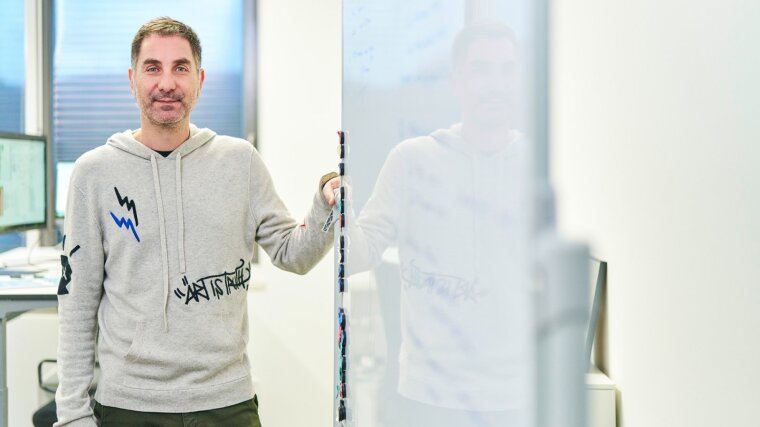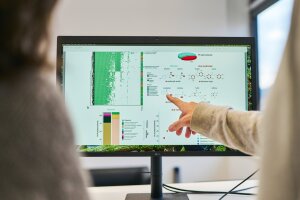
Just like plants, animals and bodies of water, the human body is home to entire communities of tiny
organisms like bacteria and fungi, for example in the gut. Prof. Dr Gianni Panagiotou is a specialist in this
field. As part of the Cluster of Excellence »Balance of the Microverse«, the systems biologist and his team are examining how gut flora influence the development and progression of diseases.
By Laura Weißert
Gianni Panagiotou and his team analyse genome data collected from stool samples. »The intestinal microbiome is particularly fascinating because, unlike human genetic material, the genetic material of gut bacteria can be altered—for example, by changes in diet, nutritional supplements or lifestyle,« says Panagiotou. As he explains, implementing these changes does not necessarily require a visit to your doctor. Instead, you can eat more dietary fibre, and less fat or exercise regularly, because these factors all influence the gut flora. »In a week's time, with a completely different diet, you can see changes in your microbiome.«
With this in mind, it’s hardly surprising that the intestinal microbiome also plays a role in certain illnesses, from diabetes to bowel cancer to infections. The researchers hope to exploit this fact and find ways to improve human health by inducing intestinal bacteria to produce very specific molecules, such as short-chain fatty acids, bile acid and indole derivatives. These bacterial metabolic products are beneficial for maintaining balance in the digestive system, including by reducing inflammation. »The goal is always the same,« says Panagiotou. »We want to understand how we can manipulate this community, which works together synergistically, to do what we want it to do.«
Panagiotou and his team analyse the intestinal microorganisms and their metabolism on a screen.
Image: Anna SchrollPrebiotic effects of resistant starch
One focus of Panagiotou’s research group is the relationship between nutrition and intestinal bacteria. This includes altering the microbiome through targeted changes in diet. The researchers have successfully demonstrated that a diet based on resistant starch fosters a beneficial composition of the gut microbiome, which in turn has a number of positive effects on health. This dietary fibre, which can be found in foods such as bread, pasta and legumes, cannot be digested by the human body. Instead, it serves as nutrition for gut bacteria and thereby has a prebiotic effect.
A study has shown that the metabolization of resistant starch leads to an increase in levels of beneficial bacteria, while levels of harmful bacteria fall. It identified a reduction in Bacteroides stercosis, which correlates closely with liver enzymes. Resistant starch can, therefore, help to slow the progression of metabolic dysfunction-associated steatotic liver disease (MASLD, previously non-alcoholic fatty liver disease). And, by supporting the bifidobacterium B. adolescentis, resistant starch can also promote weight loss to some extent and improve insulin sensitivity.
At present, the researchers are focusing on how microbes can alter the composition of food. As Panagiotou explains, when our gut bacteria digest food, the chemical components of the food change. However, as the composition of the gut microbiome is not universally consistent, not everyone processes food in the same way. This is why a diet generally considered healthy will not necessarily have a positive effect on a person’s health. Panagiotou notes that healthy people and people with chronic inflammatory bowel diseases (e.g.
Crohn’s disease) process an anti-inflammatory diet differently.
Experiments have shown strawberries, which are renowned for their anti-inflammatory properties, to be far more effective in mice with a normal gut microbiome than in germ-free mice that lacked intestinal bacteria. »With this project, we are challenging the concept of a healthy diet. Because only in combination with the right microbiome we can maximize the benefits of a diet.«
Gut microbiome influences risk of sepsis
Panagiotou’s research does not only aim to develop potential therapies, the outcomes are also significant for diagnostic purposes. Diagnosing non-alcoholic fatty liver disease, for example, requires a liver biopsy. Not only does this procedure entail health risks, it is also expensive. As an alternative, Panagiotou and his team are sequencing the gut microbiome of people with MASLD in order to determine their disease stage. In the future, a stool sample might be sufficient to determine whether or not an individual has the disease.
Together with Prof. Dr Michael Bauer, the Director of the Clinic of Anaesthesiology and Intensive Care Medicine at Jena University Hospital, Panagiotou’s working group is also exploring the role that the human microbiome plays in sepsis. »We’ve discovered that the severity of sepsis depends on the composition of the microbiome,« says Panagiotou.
By analysing the gut microbiome of 80 patients with sepsis, the researchers identified a bacterium from the Bacteroidota community that increased the survival rate of test animals by 60% following prophylactic administration. »We hope that we can also apply this to patients with a high risk of sepsis in the future.«
Panagiotou regards the opportunity to collaborate with researchers from different disciplines within the Cluster of Excellence as a significant advantage. He believes that, without this kind of network, his research would not be possible. With this in mind, Panagiotou hopes that funding for the Microverse Cluster will be extended. It would provide resources that could elevate his research to the next level: »I am confident that in seven years we will be able to engineer the microbiome in the clinic in order to use it as a companion therapeutic or even as the main therapy for managing septic patients.«
07745 Jena Google Maps site planExternal link
